Charles E W Bean, Diaries, AWM38 3DRL 606/227/1 - Folder - Part 13
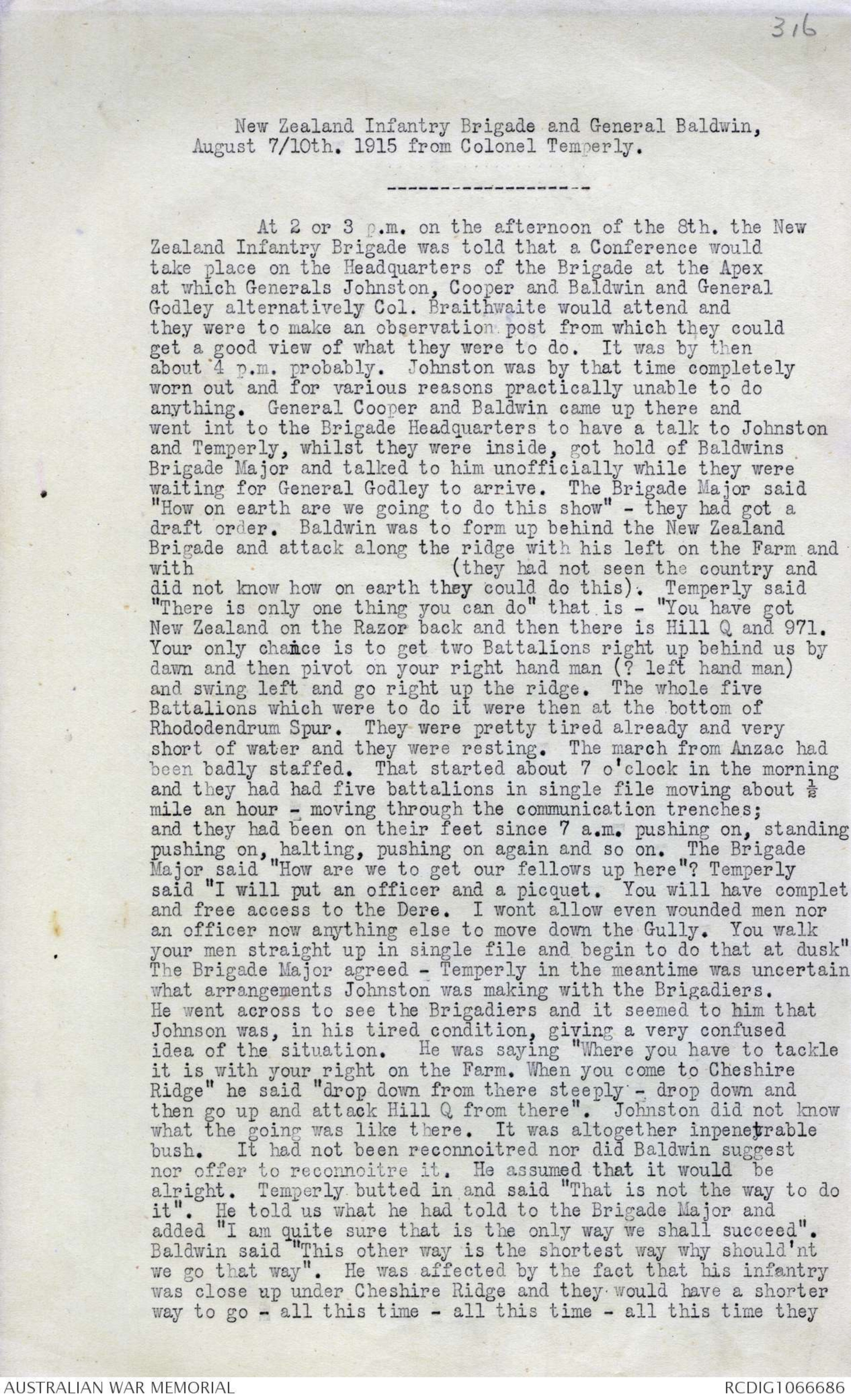
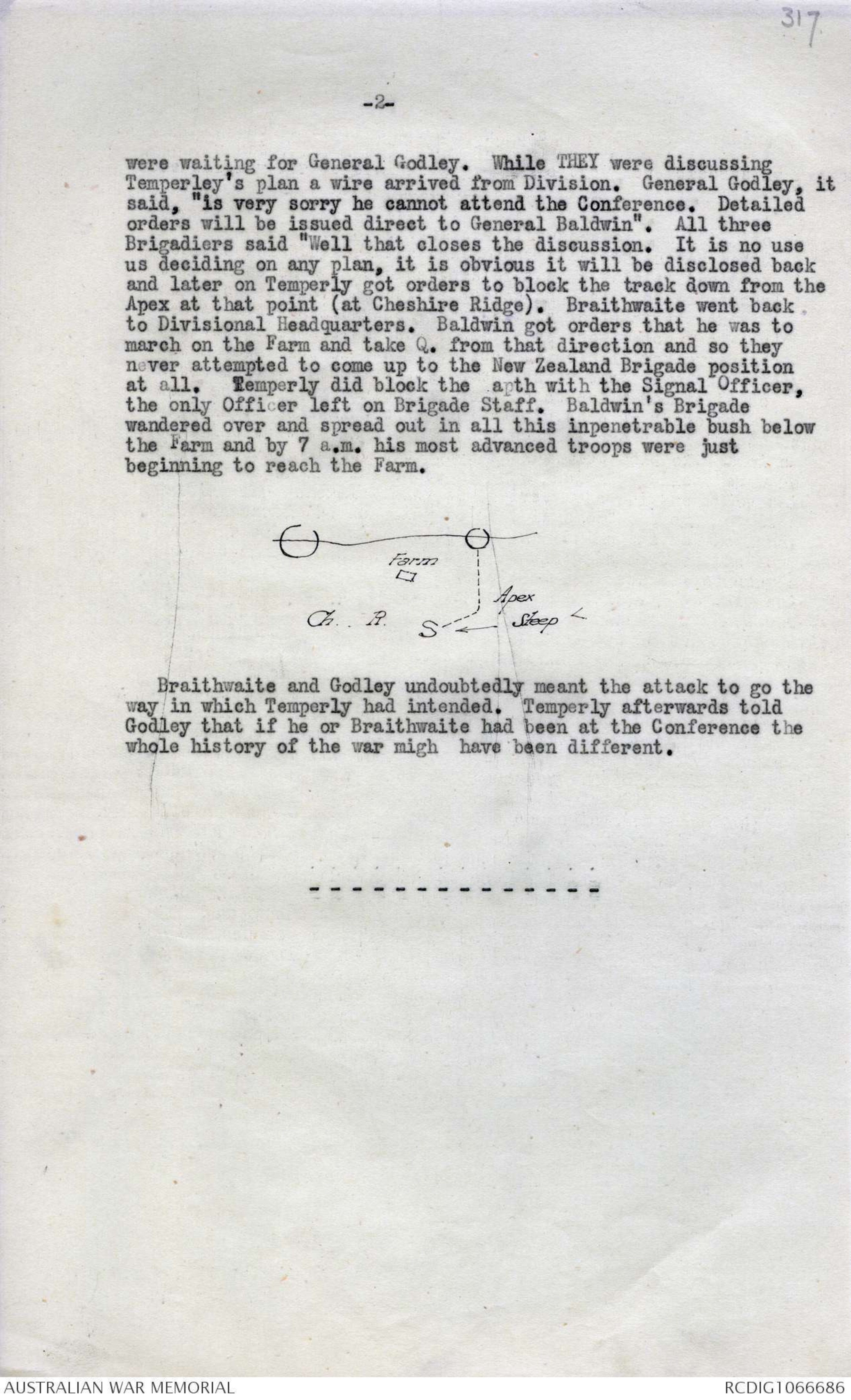
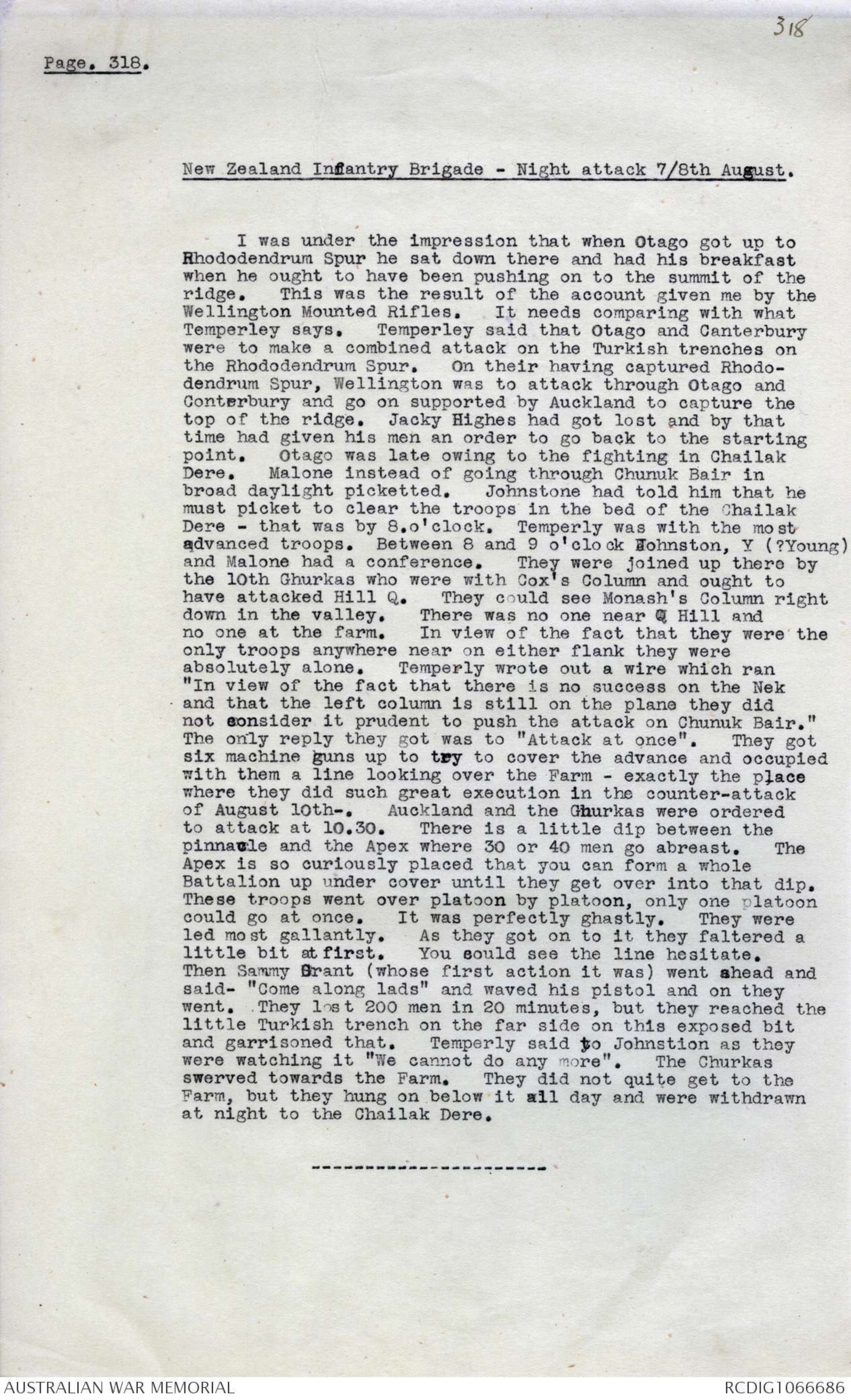
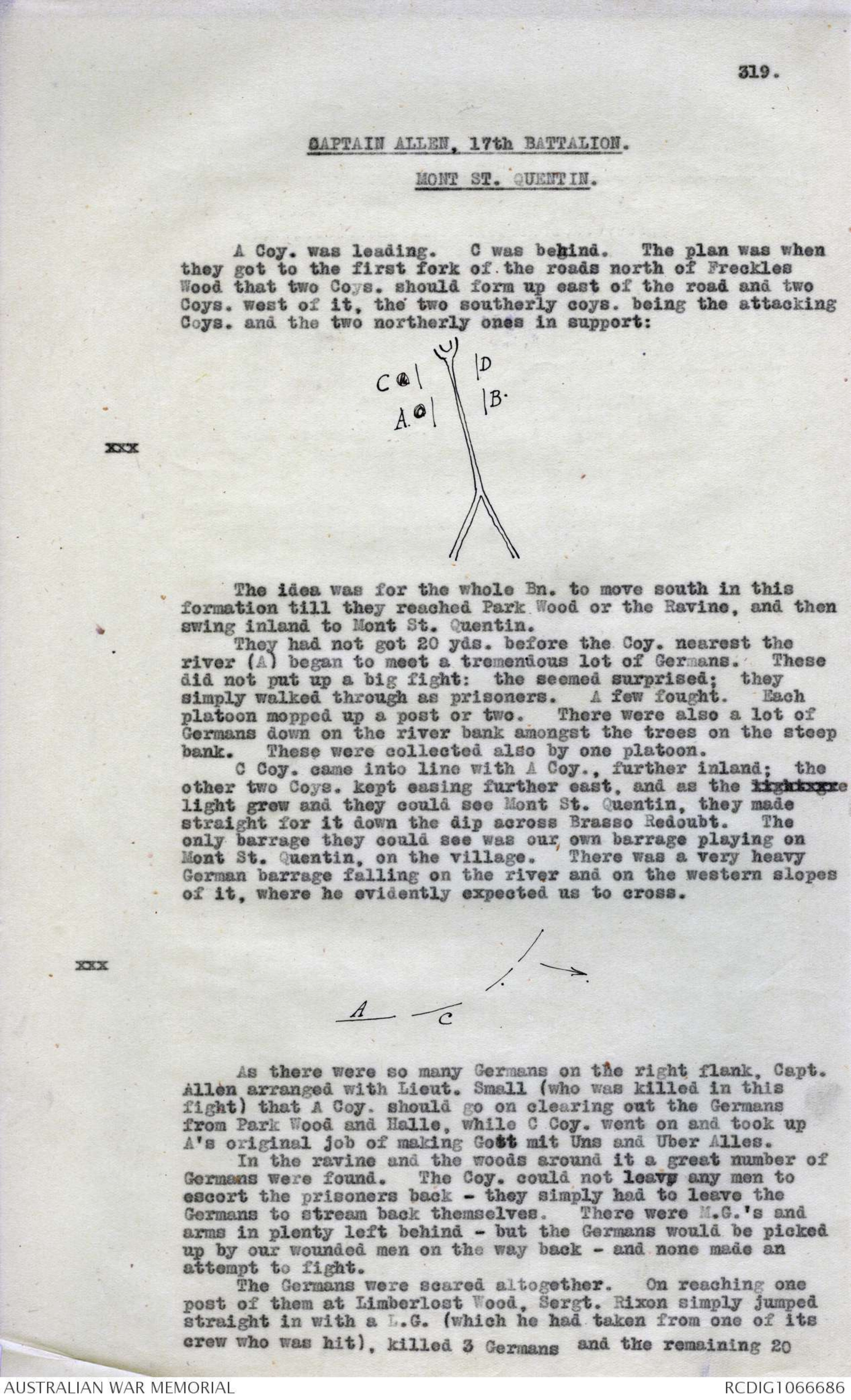
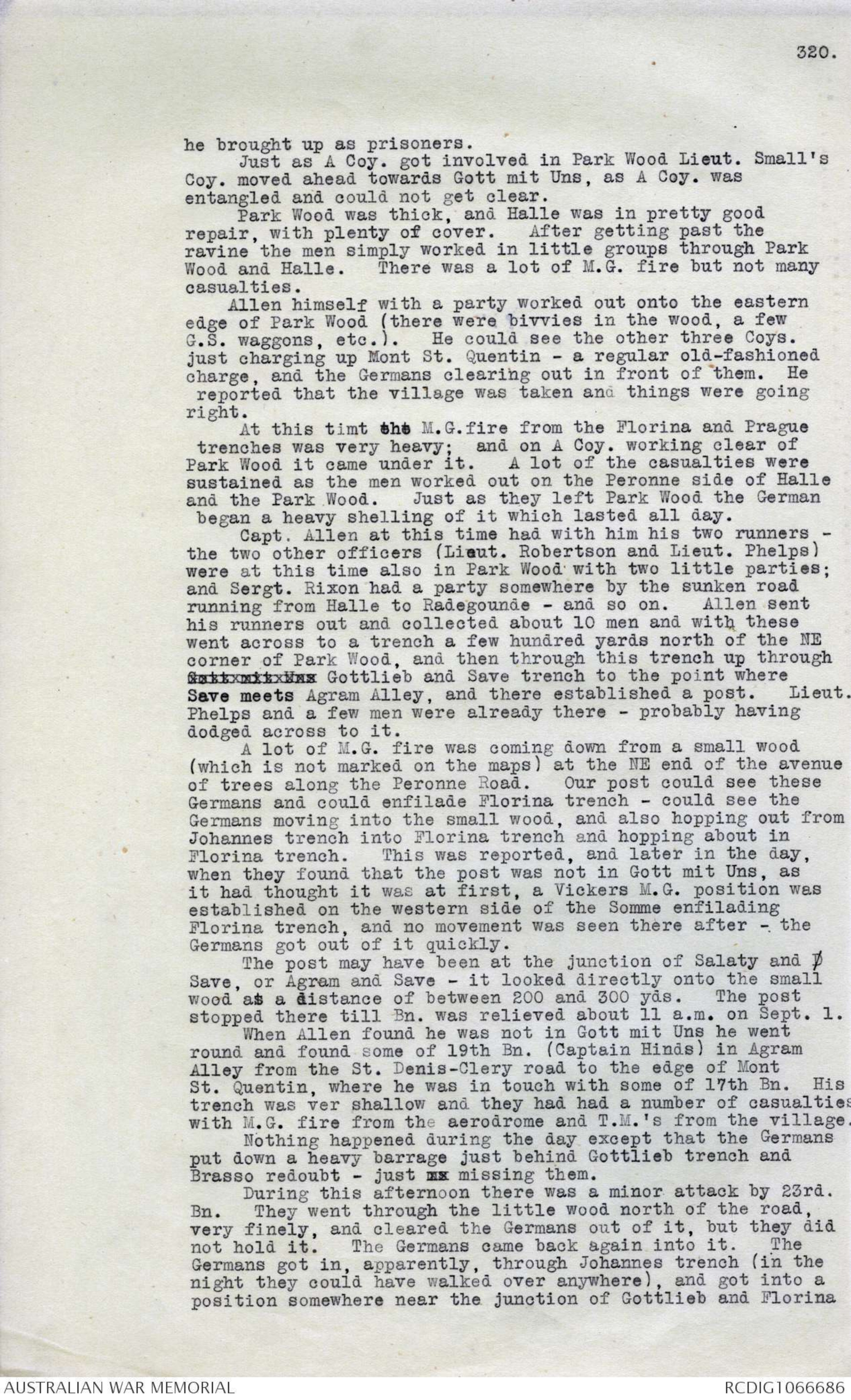
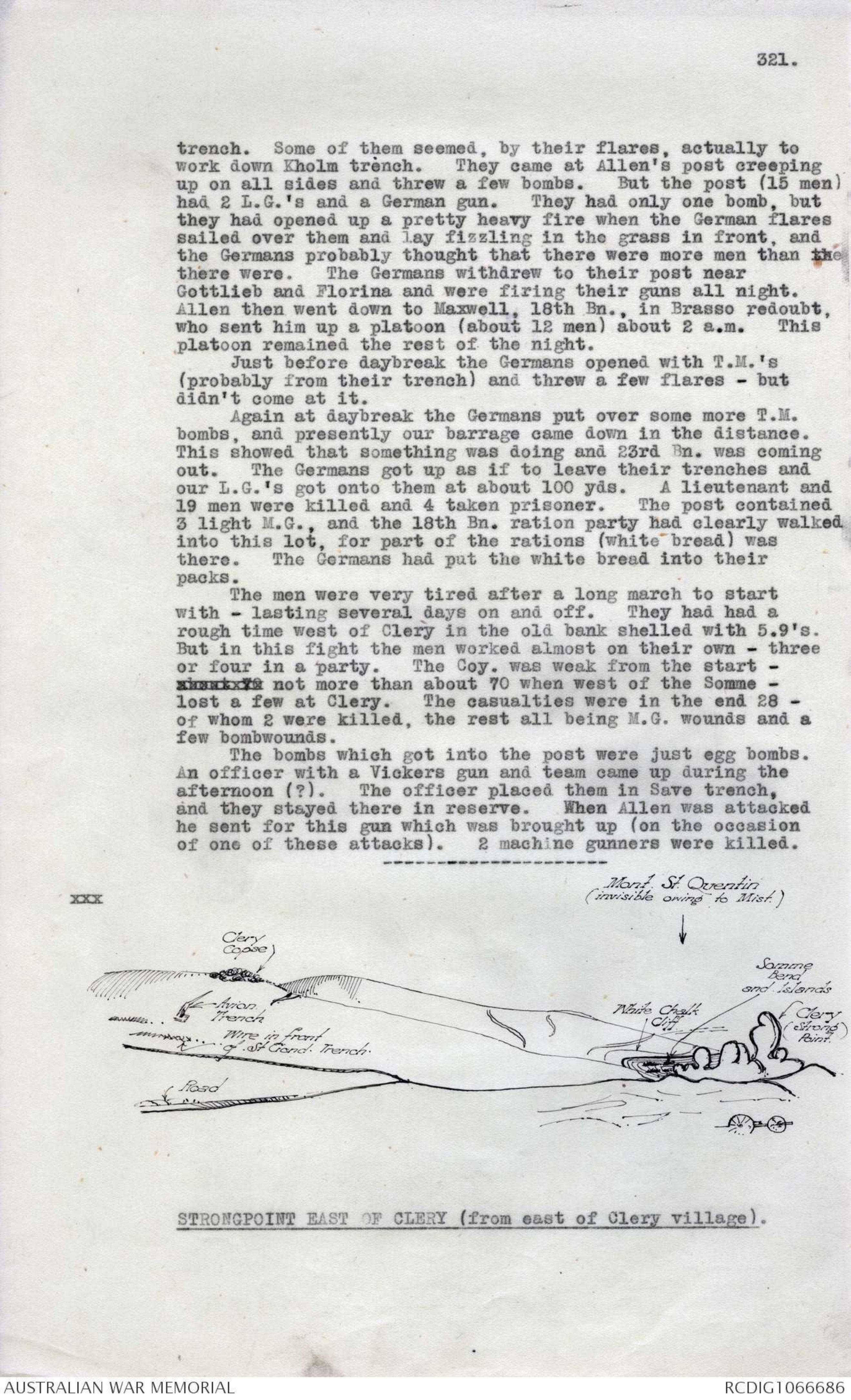
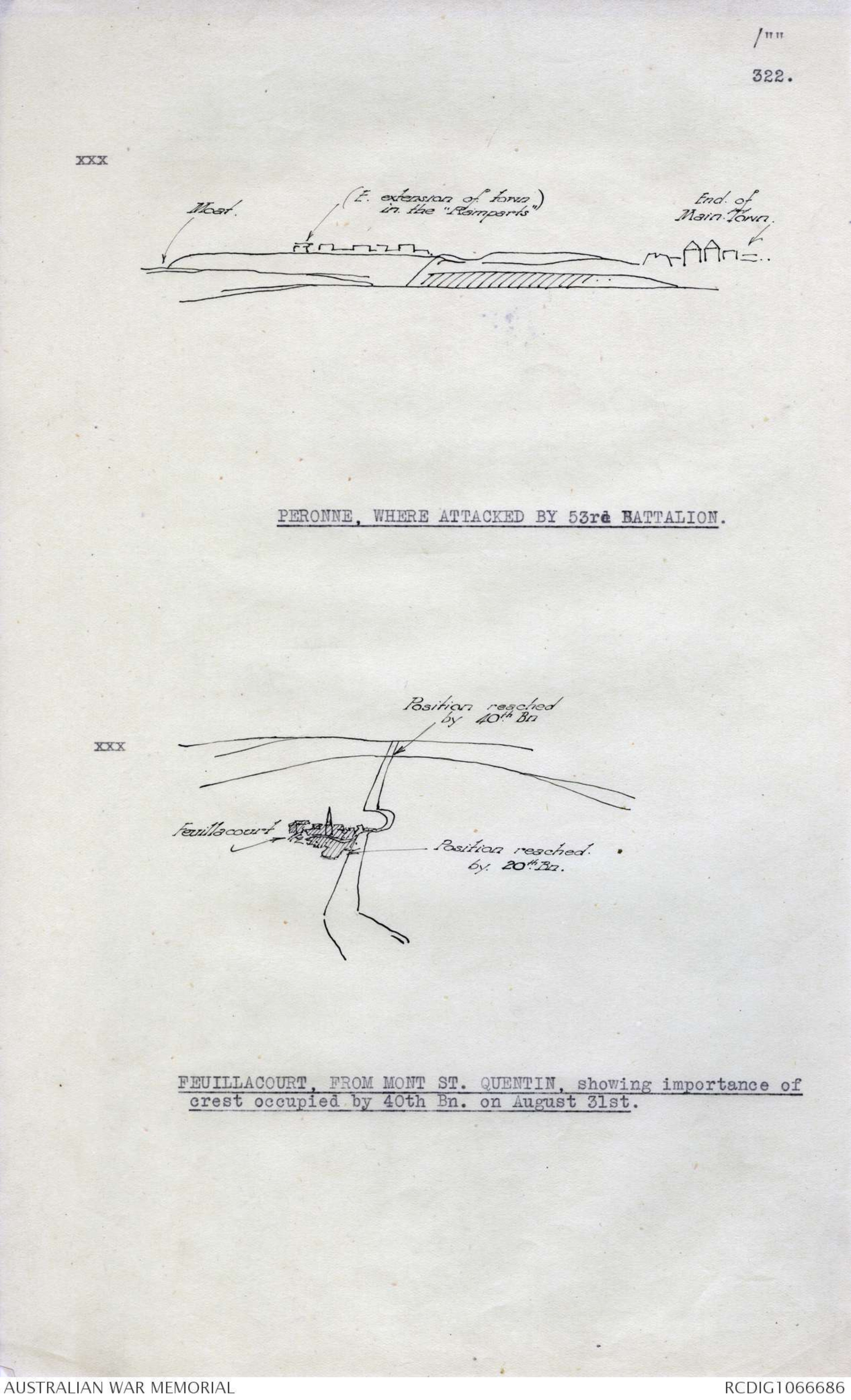
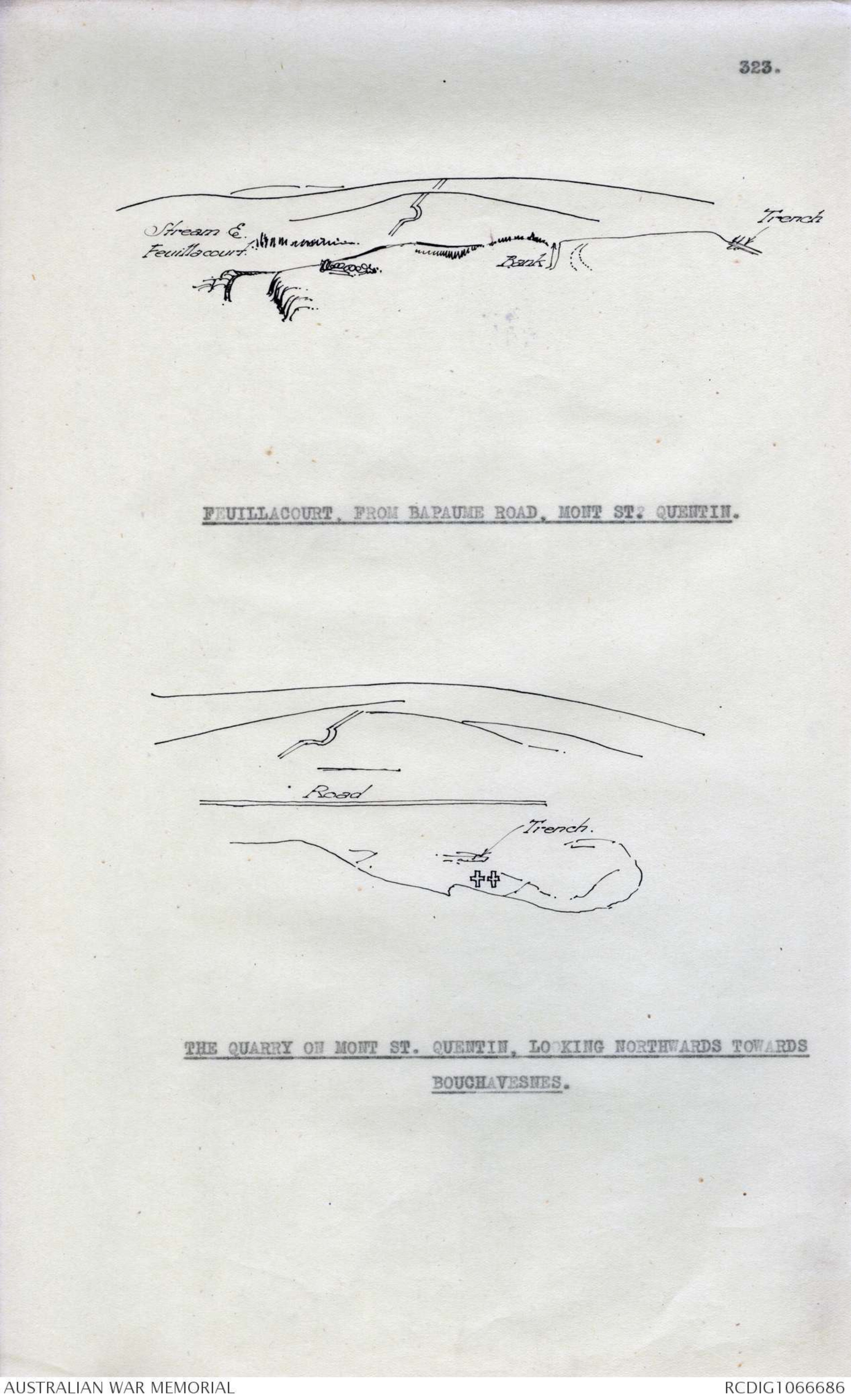
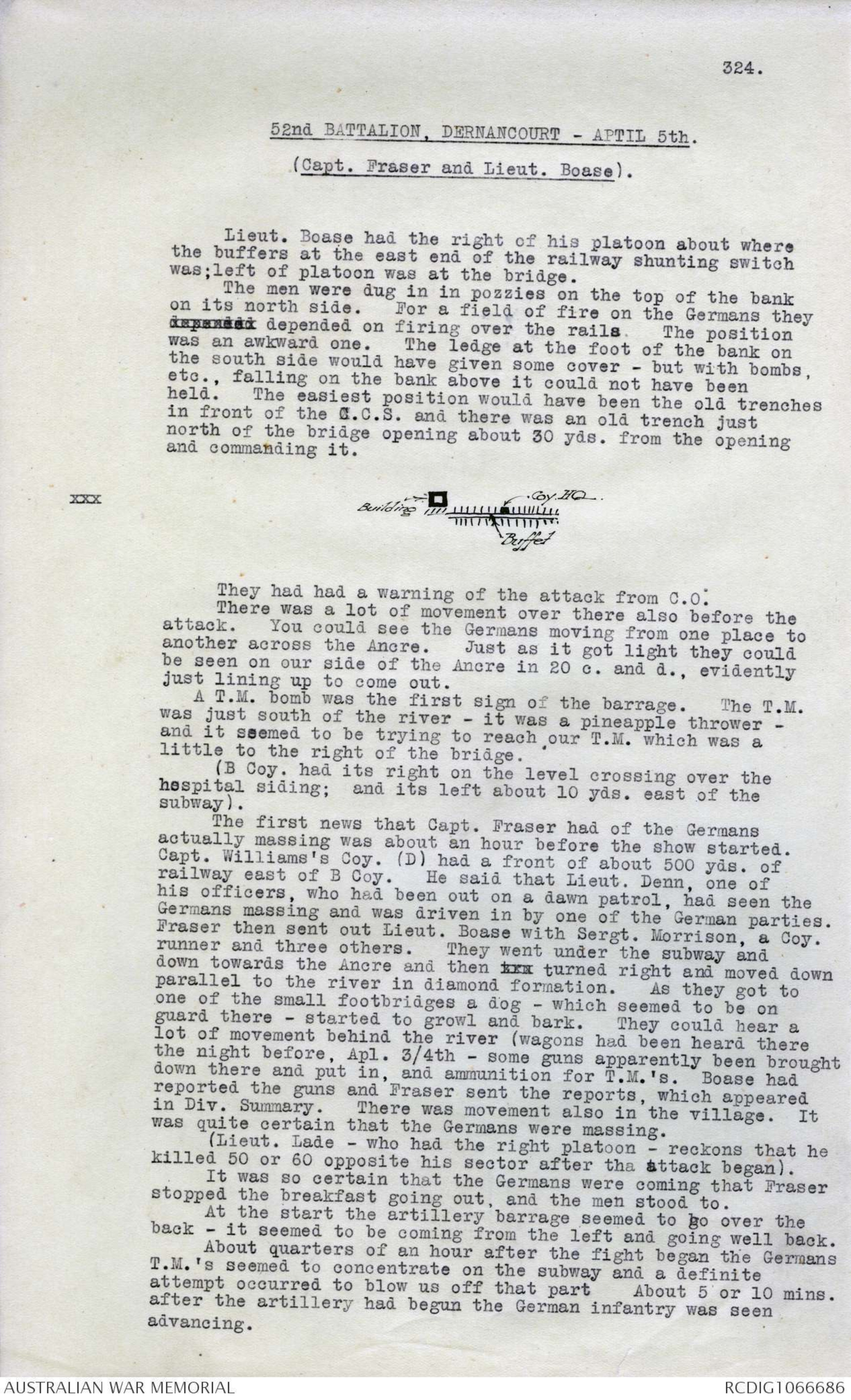
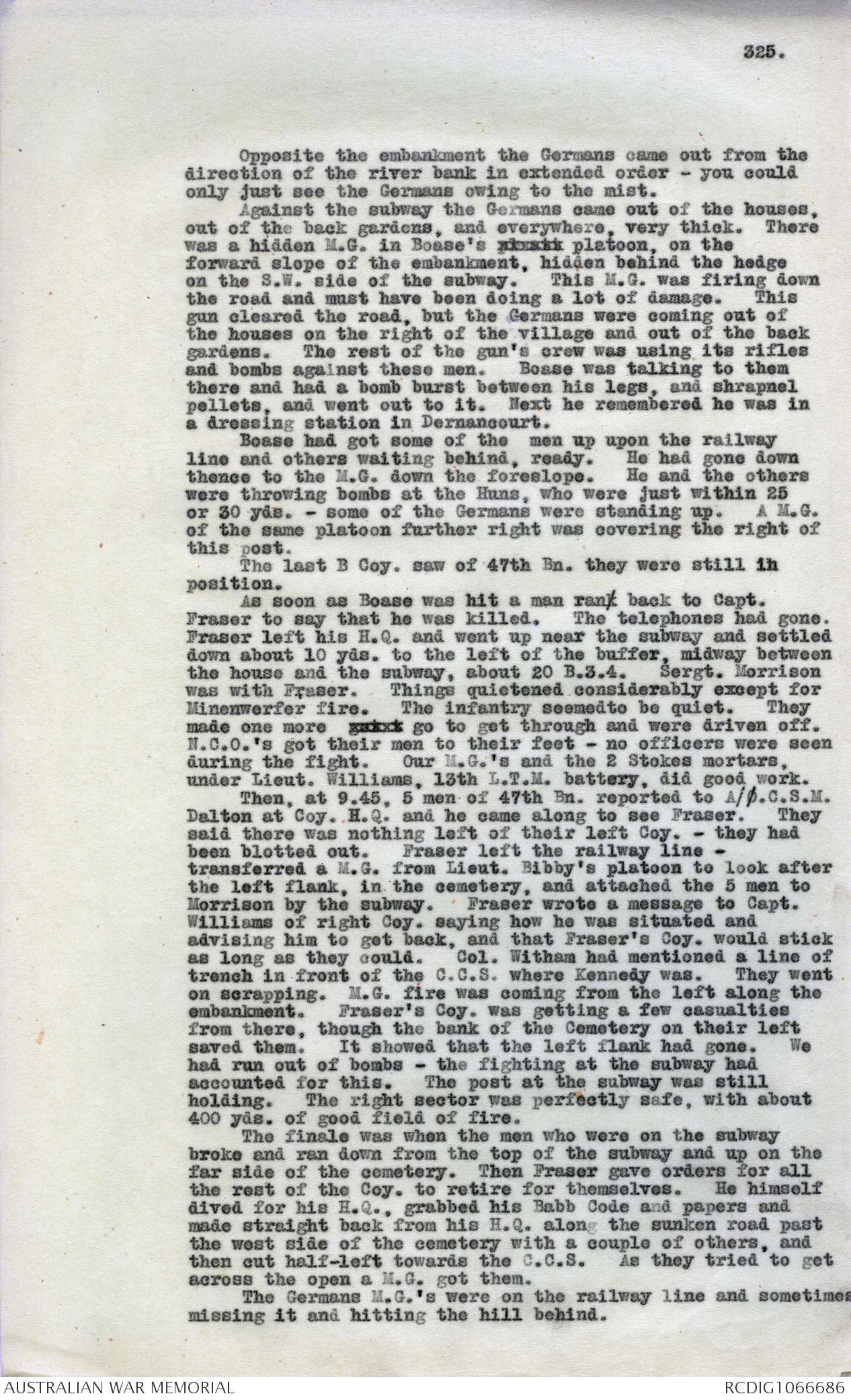
316
New Zealand Infantry Brigade and General Baldwin,
August 7/10th. 1915 From Colonel Temperly.
At 2 or 3 p.m. on the afternoon of the 8th. the New
Zealand Infantry Brigade was told that a Conference would
take place on the Headquarters of the Brigade at the Apex
at which Generals Johnston, Cooper and Baldwin and General
Godley alternatively Col. Braithwaite would attend and
they were to make an observation post from which they could
get a good view of what they were to do. It was by then
about 4 p.m. probably. Johnston was by that time completely
worn out and for various reasons practically unable to do
anything. General Cooper and Baldwin came up there and
went int to the Brigade Headquarters to have a talk to Johnston
and Temperly, whilst they were inside, got hold of Baldwins
Brigade Major and talked to him unofficially while they were
waiting for General Godley to arrive. The Brigade Major said
"How on earth are we going to do this show" - they had got a
draft order. Baldwin was to form up behind the New Zealand
Brigade and attack along the ridge with his left on the Farm and
with (they had not seen the country and
did not know how on earth they could do this). Temperly said
"There is only one thing you can do" that is - "You have got
New Zealand on the Razor back and then there is Hill Q and 971.
Your only chance is to get two Battalions right up behind us by
dawn and then pivot on your right hand man (? left hand man)
and swing left and go right up the ridge. The whole five
Battalions which were to do it were then at the bottom of
Rhododendrum Spur. They were pretty tired already and very
short of water and they were resting. The march from Anzac had
been badly staffed. That started about 7 o'clock in the morning
and they had had five battalions in single file moving abut ½
mile an hour - moving through the communication trenches;
and they had been on their feet since 7 a.m. pushing on, standing
pushing on, halting, pushing on again and so on. The Brigade
Major said "How are we to get our fellows up here"? Temperly
said "I will put an officer and a picquet. You will have complet
and free access to the Dere. I wont allow even wounded men nor
an officer now anything else to move down the Gully. You walk
your men straight up in single file and begin to do that at dusk"
The Brigade Major agreed - Temperly in the meantime was uncertain
what arrangements Johnston was making with the Brigadiers.
He went across to the Brigadiers and it seemed to him that
Johnston was, in his tired condition, giving a very confused
idea of the situation. He was saying "Where you have to tackle
it is with your right on the Farm. When you come to Cheshire
Ridge" he said "drop down from there steeply - drop down and
then go up and attack Hill Q from there". Johnston did not know
what the going was like there. it was altogether inpenetrable
bush. It had not been reconnoitred nor did Baldwin suggest
nor offer to reconnoitre it. He assumed that it would be
alright. Temperly butted in and said "That is not the way to do
it". He told us what he had told to the Brigade Major and
added "I am quite sure that is the only way we shall succeed".
Baldwin said "This other way is the shortest way why should'nt
we go that way". He was affected by the fact that his infantry
was close up under Cheshire Ridge and they would have a shorter
way to go - all this time - all this time - all this time they
317
-2-
were waiting for General Godley. While THEY were discussing
Temperley's plan a wire arrived from Division. General Godley, it
said, "is very sorry he cannot attend the Conference. Detailed
orders will be issued direct to General Baldwin". All three
Brigadiers said "Well that closes the discussion. It is no use
us deciding on any plan, it is obvious it will be disclosed back
and later on Temperly got orders to block the track down from the
Apex at that point (at Cheshire Ridge). Braithwaite went back
to Divisional Headquarters. Baldwin got orders that he was to
march on the Farm and take Q. from that direction and so they
never attempted to come up to the New Zealand Brigade position
at all. Temperley did block the apth witht Signal Officer,
the only Officer left on Brigade Staff. Baldwin's Brigade
wandered over and spread out in all this inpenetrable bush below
the Farm and by 7 a.m. his most advanced troops were just
beginning to reach the Farm.
Diagram - See original document
Braithwaite and Godley undoubtedly meant the attack to go the
way in which Temperly had intended. Temperly afterwards told
Godley that if he or Braithwaite had been at the Conference the
whole history of the war migh have been different.
318
Page. 318.
New Zealand Infantry Brigade - Night attack 7/8th August.
I was under the impression that when Otago got up to
Rhododendrum Spur he sat down there and had his breakfast
when he ought to have been pushing on to the summit of the
ridge. This was the result of the account given me by the
Wellington Mounted Rifles. It needs comparing with what
Temperley says. Temperley said that Otago and Canterbury
were to make a combined attack on the Turkish trenches on
the Rhododendrum Spur. On their having captured Rhodo-
dendrum Spur, Wellington was to attack through Otago and
Conterbury and go on supported by Auckland to capture the
top of the ridge. Jacky Highes had got lost and by that
time had given his men an order to go back to the starting
point. Otago was late owing to the fighting in Chailak
Dere. Malone instead of going through Chunuk Bair in
broad daylight picketted. Johnstone had told him that he
must picket to clear the troops in the bed of the Chailak
Dere - that was by 8.o'clock. Temperly was with the most
advanced troops. Between 8 and 9 o'clock Johnston, Y (?Young)
and Malone had a conference. They were joined up there by
the 10th Ghurkas who were with Cox's Column and ought to
have attacked Hill Q. They could see Monash's Column right
down in the valley. There was no one near Q Hill and
no one at the farm. In view of the fact that they were the
only troops anywhere near on either flank they were
absolutely alone. Temperly wrote out a wire which ran
"In view of the fact that there is no success on the Nek
and that the left column is still on the plane they did
not consider it prudent to push the attack on Chunuk Bair."
The only reply they go was to "Attack at once". They got
six machine guns up to try to cover the advance and occupied
with them a line looking over the Farm - exactly the place
where they did such great execution in the counter-attack
of August 10th-. Auckland and the Ghurkas were ordered
to attack at 10.30. There is a little dip between the
pinnacle and the Apex where 30 or 40 go abreast. The
Apex is so curiously placed that you can form a whole
Battalion up under cover until they get over into that dip.
These troops went over platoon by platoon, only one platoon
could go at once. It was perfectly ghastly. They were
led most gallantly. As they got on to it they faltered a
little bit at first. You could see the line hesitate.
Then Sammy Grant (whose first action it was) went ahead and
said- "Come along lads" and waved his pistol and on they
went. They lost 200 men in 20 minutes, but they reached the
little Turkish trench on the far side on this exposed bit
and garrisoned that. Temperly said to Johnstion as they
were watching it "We cannot do any more". The Churkas
swerved towards the Farm. They did not quite get to the
Farm, but they hung on below it all day and were withdrawn
at night to the Chailak Dere.
319.
Captain Allen, 17th Battalion.
Mont St. Quentin.
A Coy. was leading. C was behind. The plan was when
they got to the first fort of the roads north of Freckles
Wood that two Coys. should form up east of the road and two
Coys. west of it, the two southerly coys. being the attacking
Coys. and the two northerly ones in support:
Diagram - See original document
The idea was for the whole Bn. to move south in this
formation till they reached Park Wood or the Ravine, and then
swing inland to Mont St. Quentin.
They had not got 20 yds. before the Coy. nearest the
river (A) began to meet a tremendous lot of Germans. These
did not put up a big fight: the seemed surprised; they
simply walked through as prisoners. A few fought. Each
platoon mopped up a post or two. There were also a lot of
Germans down on the river bank amongst the trees on the steep
bank. These were collected also by one platoon.
C Coy. came into line with A Coy., further inland; the
other two Coys. kept easing further east, and as the light gre
light grew and they could see Mont St. Quentin, they made
straight for it down the dip across Brasso Redoubt. The
only barrage they could see was our own barrage playing on
Mont St. Quentin, on the village. There was a very heavy
German barrage falling on the river and on the western slopes
of it, where he evidently expected us to cross.
Diagram - See original document
As there were so many Germans on the right flank, Capt.
Allen arranged with Lieut. Small (who was killed in this
fight) that A Coy. should go on clearing out the Germans
from Park Wood and Halle, while C Coy. went on and took up
A's original job of making Gott mit Uns and Uber Alles.
In the ravine and the woods around it a great number of
Germans were found. The Coy. could not leave any men to
escort the prisoners back - they simply had to leave the
Germans to stream back themselves. There were M.G.'s and
arms in plenty left behind - but the Germans would be picked
up by our wounded men on the way back - and none made an
attempt to fight.
The Germans were scared altogether. On reaching one
post of them at Limberlost Wood, Sergt. Rixon simply jumped
straight in with a L.G. (which he had taken from one of its
crew who was hit), killed 3 Germans and the remaining 20
320.
he brought up as prisoners.
Just as A Coy. got involved in Park Wood Lieut. Small's
Coy. moved ahead towards Gott mit Uns, as A Coy. was
entangled and could not get clear.
Park Wood was thick, and Halle was in pretty good
repair, with plenty of cover. After getting past the
ravine the men simply worked in little groups through Park
Wood and Halle. There was a lot of M.G. fire but not many
casualties.
Allen himself with a party worked out onto the eastern
edge of Park Wood (there were bivvies in the wood, a few
G.S. waggons, etc.). He could see the other three Coys.
just charging up Mont St. Quentin - a regular old-fashioned
charge, and the Germans clearing out in front of them. He
reported that the village was taken and things were going
right.
At this time the M.G. fire from the Florina and Prague
trenches was very heavy; and on A Coy. working clear of
Park Wood it came under it. A lot of the casualties were
sustained as the men worked out on the Peronne side of Halle
and the Park Wood. Just as they left Park Wood the German
began a heavy shelling of it which lasted all day.
Capt. Allen at this time had with him his two runners -
the two other officers (Lieut. Robertson and Lieut. Phelps)
were at this time also in Park Wood with two little parties:
and Sergt. Rixon had a party somewhere by the sunken road
running from Halle to Radegounde - and so on. Allen sent
his runners out and collected about 10 men and with these
across to a trench a few hundred yards north of the NE
corner of Park Wood, and then through this trench up through xxxxxxxxxxxx Gottlieb and Save trench to the point where
Save meets Agram Alley, and there established a post. Lieut.
Phelps and a few men were already there - probably having
dodged across to it.
A lot of M.G. fire was coming down from a small wood
(which is not marked on the maps) at the NE end of the avenue
of trees along the Peronne Road. Our post could see these
Germans and could enfilade Florina trench - could see the
Germans moving into the small wood, and also hopping out from
Johannes trench into Florina trench and hopping about in
Florina trench. This was reported, and later in the day,
when they found that the post was not in Gott mit Uns, as
it had thought it was at first, a Vickers M.G. position was
established on the western side of the Somme enfilading
Florina trench, and no movement was seen there after - the
Germans got out of it quickly.
The post may have been at the junction of Salaty and D
Save, or Agram and Save - it looked directly onto the small
wood at a distance of between 200 and 300 yds. The post
stopped there till Bn. was relieved about 11 a.m. on Sept. 1.
When Allen found he was not in Gott mit Uns he went
round and found some of 19th Bn. (Captain Hinds) in Agram
Alley from the St. Denis-Clery road to the edge of Mont
St. Quentin, where he was in touch with some of 17th Bn. His
trench was ver shallow and they had had a number of casualties
with M.G. fire from the aerodrome and T.M.'s from the village.
Nothing happened during the day except that the Germans
put down a heavy barrage just behind Gottlieb trench and
Brasso redoubt - just xx missing them.
During this afternoon there was a minor attack by 23rd.
Bn. They went through the little wood north of the road,
very finely, and cleared the Germans out of it, but they did
not hold it. The Germans came back again into it. The
Germans got in, apparently, through Johannes trench (in the
night they could have walked over anywhere), and got into a
position somewhere near the junction of Gottlieb and Florina
321.
trench. Some of them seemed, by their flares, actually to
work down Kholm trench. They came at Allen's post creeping
up on all sides and threw a few bombs. But the post (15 men)
had 2 L. G.'s and a German gun. They had only one bomb, but
they had opened up a pretty heavy fire when the German flares
sailed over them and lay fizzling in the grass in front, and
the Germans probably thought that there were more men that the
there were. The Germans withdrew to their post near
Gottlieb and Florina and were firing their guns all night.
Allen then went down to Maxwell, 18th Bn., in Brasso redoubt,
who sent him up a platoon (about 12 men) about 2 a.m. This
platoon remained the rest of the night.
Just before daybreak the Germans opened with T.M.'s
(probably from their trench) and threw a few flares - but
didn't come at it.
Again at daybreak the Germans put over some more T.M.
bombs, and presently our barrage came down in the distance.
This showed that something was doing and 23rd Bn. was coming
out. The Germans got up as if to leave their trenches and
our L.G.'s got onto them at about 100 yds. A lieutenant and
19 men were killed and 4 taken prisoner. The post contained
3 light M. G., and the 18th Bn. ration party had clearly walked
into this lot, for part of the rations (white bread) was
there. The Germans had put the white bread into their
packs.
The men were very tired after a long march to start
with - lasting several days on and off. They had had a
rough time west of Clery in the old bank shelled with 5.9's.
But in this fight the men worked almost on their own - three
or four in a party. The Coy. was weak from the start -
xxxxxxxx not more than about 70 when west of the Somme -
lost a few at Clery. The casualties were in the end 28 -
of whom 2 were killed, the rest all being M. G. wounds and a
few bombwounds.
The bombs which got into the post were just egg bombs.
an officer with a Vickers gun and team came up during the
afternoon (?). The officer placed them in Save trench,
and they stayed there in reserve. When Allen was attacked
he sent for this gun which was brought up (on the occasion
of one of these attacks). 2 machine gunners were killed.
Diagram - See original document
STRONGPOINT EAST OF CLERY (from east of Clery village).
/""
322.
Diagram - See original document
PERONNE, WHERE ATTACKED BY 53rd BATTALION.
Diagram - See original document
FEUILLACOURT, FROM MONT ST. QUENTIN, showing importance of
crest occupied by 40th Bn. on August 31st.
323.
Diagram - See original document
FEUILLACOURT. FROM BAPAUME ROAD, MONT ST. QUENTIN.
Diagram - See original document
THE QUARRY ON MONT ST. QUENTIN, LOOKING NORTHWARDS TOWARDS
BOUCHAVESNES.
324.
52nd BATTALION, DERNANCOURT - APTIL 5th.
(Capt. Fraser and Lieut. Boase).
Lieut. Boase had the right of his platoon about where
the buffers at the east end of the railway shunting switch
was; left of the platoon was at the bridge.
The men were dug in in pozzies on the top of the bank
on its north side. For a field of fire on the Germans they
xxxxxxxx depended on firing over the rails. The position
was an awkward one. The ledge at the foot of the bank on
the south side would have given some cover - but with bombs,
etc., falling on the bank above it could not have been
held. The easiest position would have been the old trenches
in front of the C. C. S. and there was an old trench just
north of the bridge opening about 30 yds. from the opening
and commanding it.
Diagram - See original document
They had had a lot of warning of the attack from C.O.
There was a lot of movement over there also before the
attack. You could see the Germans moving from one place to
another across the Ancre. Just as it got light they could
be seen on our side of the Ancre in 20 c. and d., evidently
just lining up to come out.
A T.M. bomb was the first sign of the barrage. The T. M.
was just south of the river - it was a pineapple thrower -
at it seemed to be trying to reach our T. M. which was a
little to the right of the bridge.
(B Coy. had its rights on the level crossing over the
hospital siding; and its left about 10 yds. east of the
subway).
The first news that Capt. Fraser had of the Germans
actually massing was about an hour before the show started.
Capt. Williams's Coy. (D) had a front of about 500 yds. of
railway east of B Coy. He said that Lieut. Denn, one of
his officers, who had been out on a dawn patrol, had seen the
Germans massing and was driven in by one of the German parties
Fraser then sent out Lieut. Boase with Sergt. Morrison, a Coy.
runner and three others. They went under the subway and
down towards the Ancre and then xxx turned right and moved down
parallel to the river in diamond formation. As they got to
one of the small footbridges a dog - which seemed to be on
guard there - started to growl and bark. They could hear a
lot of movement behind the river (wagons had been heard there
the night before, Apl. 3/4th - some guns apparently been brought
down there and put in, and ammunition for T. M.'s. Boase had
reported the guns and Fraser sent the reports, which appeared
in Div. Summary. There was movement also in the village. It
was quite certain that the Germans were massing.
(Lieut. Lade - who had the right platoon - reckons that he
killed 50 or 60 opposite his sector after tha attack began).
It was so certain that the Germans were coming that Fraser
stopped the breakfast going out, and the men stood to.
At the start the artillery barrage seemed to go over the
back - it seemed to be coming from the left and going well back.
About quarters of an hour after the fight began the Germans
T. M.'s seemed to concentrate on the subway and a definite
attempt occurred to blow us off that part About 5 or 10 mins.
after the artillery had begun the German infantry was seen
advancing.
325.
Opposite the embankment the Germans came out from the
direction of the river bank in extended order - you could
only just see the Germans owing to the mist.
Against the subway the Germans came out of the houses,
out of the back gardens, and everywhere, very thick. There
was a hidden M. G. in Boase's xxxxxx platoon, on the
forward slope of the embankment, hidden behind the hedge
on the S. W. side of the subway. This M. G. was firing down
the road and must have been doing a lot of damage. This
gun cleared the road, but the Germans were coming out of
the houses on the right of the village and out of the back
gardens. The rest of the gun's crew was using its rifles
and bombs against these men. Boase was talking to them
there and had a bomb burst between his legs, and shrapnel
pellets, and went out to it. Next he remembered he was in
a dressing station in Dernancourt.
Boase had got some of the men up upon the railway
line and other waiting behind, ready. He had gone down
thence to the M. G. down the foreslope. he and the others
were throwing bombs at the Huns, who were just within 25
or 30 yds. - some of the Germans were standing up. A M.G.
of the same platoon further right was covering the right of
this post.
The last B Coy. saw of 47th Bn. they were still in
position.
As soon as Boase was hit a man rank back to Capt.
Fraser to say that he was killed. The telephones had gone.
Fraser left his H. Q. and went up near the subway and settled
down about 10 yds. to the left of the buffer, midway between
the house and the subway, about 20 B.3.4. Sergt. Morrison
was with Fraser. Things quietened considerably except for
Minenwerfer fire. The infantry seemed to be quiet. They
made one more xxxxxx go to get through and were driven off.
N.C.O.'s got their men to their feet - no officers were seen
during the fight. Our M.G.'s and the 2 Stokes mortars,
under Lieut. Williams, 13th L.T.M. battery, did good work.
Then, at 9.45, 5 men of the 47th Bn. reported to A O.C.S.M.
Dalton at Coy. H.Q. and he came along to see Fraser. They
said there was nothing left of their left Coy. - they had
been blotted out. Fraser left the railway line-
transferred a M.G. from Lieut. Bibby's platoon to look after
the left flank, in the cemetery, and attached the 5 men to
Morrison by the subway. Fraser wrote a message to Capt.
Williams of right Coy. saying how he was situation and
advising him to get back, and that Fraser's Coy. would stick
as long as they could. Col. Withan had mentioned a line of
trench in front of the C.C.S. where Kennedy was. They went
on scrapping. M.G. fire was coming from the left along the
embankment. Fraser's Coy. was getting a few casualties
from there, though the bank of the Cemetery on their left
saved them. It showed that the left flank had gone. We
had run out of bombs - the fighting at the subway had
accounted for this. The post at the subway was still
holding. The right sector was perfectly safe, with about
400 yds. of good field of fire.
The finale was when the men who were on the subway
broke and ran down from the top of the subway and up on the
far side of the cemetery. Then Fraser gave orders for all
the rest of the Coy. to retire for themselves. He himself
dived for his H.Q. grabbed his Babb Code and papers and
made straight back from his H.Q. along the sunked road past
the west side of the cemetery with a couple of others, and
then cut half-left towards the C.C.S. As they tried to get
across the open a M.G. got them.
The German M.G.'s were on the railway line and sometimes
missing it and hitting the hill behind.
 Sam scott
Sam scottThis transcription item is now locked to you for editing. To release the lock either Save your changes or Cancel.
This lock will be automatically released after 60 minutes of inactivity.